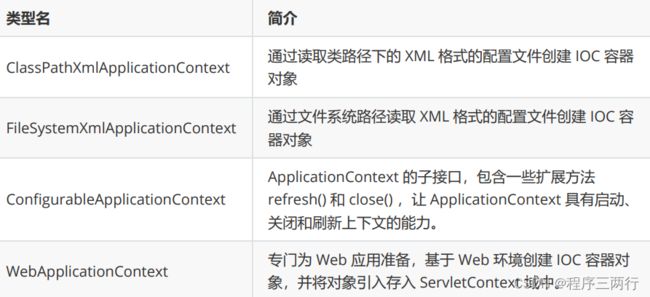Spring系列文章2:基于xml方式依赖注入
一、IOC、DI理解
IOC(控制反转):和23设计模式一样是一种思想,就是在程序中不再通过new的方式创建对象了。
DI(依赖注入):依赖指的是a对象和b对象的关系,注入是一种手段,通过这种手段让a对象和b对象产生关系,而注入包括两种常见的方式
- set注入
- 构造方式注入
IOC 就是一种反转控制的思想, 而 DI 是对 IOC 的一种具体实现,在spring中是一件事(把对对象的创建、管理、属性赋值等使用交给spring容器)
二、Spring 的 IOC 容器
Spring 的 IOC 容器就是 IOC 思想的一个落地的产品实现。IOC 容器中管理的组件也叫做 bean。在创建 bean 之前,首先需要创建 IOC 容器。Spring 提供了 IOC 容器的两种实现方式:
1、BeanFactory接口
这是 IOC 容器的基本实现,是 Spring 内部使用的接口。面向 Spring 本身,不提供给开发人员使用
2、ApplicationContext
BeanFactory 的子接口,提供了更多高级特性。面向 Spring 的使用者,几乎所有场合都使用 ApplicationContext 而不是底层的 BeanFactory。
三、基于xml方式依赖注入
1、bean的声明和使用
applicationContext.xml ,内容如下
使用方式1:根据id获取bean
测试
@Test
public void test() {
/**
* 1、从classpath加载配置文件,这里直接在resource目录下,可以自定义目录
* 2、容器对象ApplicationContext是一个接口,通过实现类ClassPathXmlApplicationContext加载文件,
* 获取其他java对象
* 3、ApplicationContext 容器,会在容器对象初始化时,读取配置文件将其中的所有对象一次性全部装配好放在map中
* 4、spring默认使用的是无参构造方法创建对象
*/
String bean = "beans.xml";
ApplicationContext ctx = new ClassPathXmlApplicationContext(bean);
StudentService service= (StudentService)ctx.getBean("helloWorld");
service.sayHello();
}Spring 底层默认通过反射技术调用组件类的无参构造器来创建组件对象,这一点需要注意。如果在需要 无参构造器时,没有无参构造器,则会抛出下面的异常:
Instantiation of bean failed; nested exception is org.springframework.beans.BeanInstantiationException: Failed to instantiate [com.bean.HelloWorld]: No default constructor found; nested exception is java.lang.NoSuchMethodException
使用方式2:根据类型获取
由于 id 属性指定了 bean 的唯一标识,所以根据 bean 标签的 id 属性可以精确获取到一个组件对象
@Test
public void testHelloWorld(){
ApplicationContext ac = new
ClassPathXmlApplicationContext("applicationContext.xml");
HelloWorld bean = ac.getBean(HelloWorld.class);
bean.sayHello();
}使用方式3:根据id和类型
@Test
public void testHelloWorld(){
ApplicationContext ac = new
ClassPathXmlApplicationContext("applicationContext.xml");
HelloWorld bean = ac.getBean("helloworld", HelloWorld.class);
bean.sayHello();
}当根据类型获取bean时,要求IOC容器中指定类型的bean有且只能有一个 当IOC容器中一共配置了两个,根据类型获取时会抛出异常:NoUniqueBeanDefinitionException
如果一个接口有多个实现类,这些实现类都配置了 bean,根据接口类型是不可以获取 bean 的
2、bean的注入
2.1、依赖注入之setter注入
测试
@Test
public void testDIBySet(){
ApplicationContext ac = new ClassPathXmlApplicationContext("spring-di.xml");
Student studentOne = ac.getBean("studentOne", Student.class);
System.out.println(studentOne);
}2.2、依赖注入之构造器注入
在Student类中添加有参构造
public Student(Integer id, String name, Integer age, String sex) {
this.id = id;
this.name = name;
this.age = age;
this.sex = sex;
}配置bean
constructor-arg标签还有两个属性可以进一步描述构造器参数:
index属性:指定参数所在位置的索引(从0开始)
name属性:指定参数名
@Test
public void testDIBySet(){
ApplicationContext ac = new ClassPathXmlApplicationContext("spring-di.xml");
Student studentOne = ac.getBean("studentTwo", Student.class);
System.out.println(studentOne);
}2.3、特殊值注入处理
①字面量赋值
什么是字面量?
int a = 10; 声明一个变量a,初始化为10,此时a就不代表字母a了,而是作为一个变量的名字。当我们引用a 的时候,我们实际上拿到的值是10。 而如果a是带引号的:'a',那么它现在不是一个变量,它就是代表a这个字母本身,这就是字面 量。所以字面量没有引申含义,就是我们看到的这个数据本身。
②null值
但是下面为name所赋的值是字符串null
③xml实体
④CDATA节
2.4、为类类型属性赋值
student有一个班级属性
private Clazz clazz;
方式二:内部bean
方式三:级联属性赋值
2.5、为数组类型属性赋值
student增加private String[] hobbies;属性
111
222
333
2.6、为集合类型属性赋值
①为List集合类型属性赋值
student增加集合属性 private List students;
bean配置
若为Set集合类型属性赋值,只需要将其中的list标签改为set标签即可
②为Map集合类型属性赋值
student有map集合private Map
bean配置
抽烟
喝酒
烫头
③引用集合类型的bean
10010
10086
抽烟
喝酒
烫头
使用util:list、util:map标签必须引入相应的命名空间,可以通过idea的提示功能选择
2.7、p命名空间
引入p命名空间后,可以通过以下方式为bean的各个属性赋值
2.8、引入外部属性文件
@Test
public void testDataSource() throws SQLException {
ApplicationContext ac = new ClassPathXmlApplicationContext("springdatasource.xml");
DataSource dataSource = ac.getBean(DataSource.class);
Connection connection = dataSource.getConnection();
System.out.println(connection);
}
2.9、bean的作用域
2.10、bean的生命周期
bean对象创建(调用无参构造器)
给bean对象设置属性
bean对象初始化之前操作(由bean的后置处理器负责)
bean对象初始化(需在配置bean时指定初始化方法)
bean对象初始化之后操作(由bean的后置处理器负责)
bean对象就绪可以使用
bean对象销毁(需在配置bean时指定销毁方法)
IOC容器关闭
public class User {
private Integer id;
private String username;
private String password;
private Integer age;
public User() {
System.out.println("生命周期:1、创建对象");
}
public User(Integer id, String username, String password, Integer age) {
this.id = id;
this.username = username;
this.password = password;
this.age = age;
}
public Integer getId() {
return id;
}
public void setId(Integer id) {
System.out.println("生命周期:2、依赖注入");
this.id = id;
}
public String getUsername() {
return username;
}
public void setUsername(String username) {
this.username = username;
}
public String getPassword() {
return password;
}
public void setPassword(String password) {
this.password = password;
}
public Integer getAge() {
return age;
}
public void setAge(Integer age) {
this.age = age;
}
public void initMethod(){
System.out.println("生命周期:3、初始化");
}
public void destroyMethod(){
System.out.println("生命周期:5、销毁");
}
@Override
public String toString() {
return "User{" +
"id=" + id +
", username='" + username + '\'' +
", password='" + password + '\'' +
", age=" + age +
'}';
}
}
配置bean
测试
@Test
public void testLife(){
ClassPathXmlApplicationContext ac = new
ClassPathXmlApplicationContext("spring-lifecycle.xml");
User bean = ac.getBean(User.class);
System.out.println("生命周期:4、通过IOC容器获取bean并使用");
ac.close();
}bean的后置处理器
bean的后置处理器会在生命周期的初始化前后添加额外的操作,需要实现BeanPostProcessor接口, 且配置到IOC容器中,需要注意的是,bean后置处理器不是单独针对某一个bean生效,而是针对IOC容 器中所有bean都会执行 创建bean的后置处理器:
public class MyBeanProcessor implements BeanPostProcessor {
@Override
public Object postProcessBeforeInitialization(Object bean, String beanName)
throws BeansException {
System.out.println("☆☆☆" + beanName + " = " + bean);
return bean;
}
@Override
public Object postProcessAfterInitialization(Object bean, String beanName)
throws BeansException {
System.out.println("★★★" + beanName + " = " + bean);
return bean;
}
}
在IOC容器中配置后置处理器:
2.11、FactoryBean
FactoryBean是Spring提供的一种整合第三方框架的常用机制。和普通的bean不同,配置一个 FactoryBean类型的bean,在获取bean的时候得到的并不是class属性中配置的这个类的对象,而是 getObject()方法的返回值。通过这种机制,Spring可以帮我们把复杂组件创建的详细过程和繁琐细节都 屏蔽起来,只把最简洁的使用界面展示给我们。 我们整合Mybatis时,Spring就是通过FactoryBean机制来帮我们创建SqlSessionFactory对象的。
创建类UserFactoryBean
public class UserFactoryBean implements FactoryBean {
@Override
public User getObject() throws Exception {
return new User();
}
@Override
public Class getObjectType() {
return User.class;
}
} 配置bean
测试
@Test
public void testUserFactoryBean(){
//获取IOC容器
ApplicationContext ac = new ClassPathXmlApplicationContext("springfactorybean.xml");
User user = (User) ac.getBean("user");
System.out.println(user);
}2.12、基于xml的自动装配
根据指定的策略,在IOC容器中匹配某一个bean,自动为指定的bean中所依赖的类类型或接口类 型属性赋值
service接口
public interface UserService {
void saveUser();
}service实现类
public class UserServiceImpl implements UserService {
private UserDao userDao;
public void setUserDao(UserDao userDao) {
}
@Override
public void saveUser() {
userDao.saveUser();
}
}
dao接口
public interface UserDao {
void saveUser();
}dao实现类
public class UserDaoImpl implements UserDao {
@Override
public void saveUser() {
System.out.println("保存成功");
}
}使用bean标签的autowire
属性设置自动装配效果
自动装配方式:byType
byType:根据类型匹配IOC容器中的某个兼容类型的bean,为属性自动赋值 若在IOC中,没有任何一个兼容类型的bean能够为属性赋值,则该属性不装配,即值为默认值 null 若在IOC中,有多个兼容类型的bean能够为属性赋值,则抛出异常 NoUniqueBeanDefinitionException
自动装配方式:byName
byName:将自动装配的属性的属性名,作为bean的id在IOC容器中匹配相对应的bean进行赋值
测试
@Test
public void testAutoWireByXML(){
ApplicationContext ac = new ClassPathXmlApplicationContext("autowirexml.xml");
UserService userService= ac.getBean(userService.class);
userService.saveUser();
}四、主配置文件中引入子配置文件
在实际Spring的开发中,service单独配置到⼀个⽂件中,dao单独配置到⼀个⽂件中,然后在核⼼配置⽂ 通过import引⼊
主配置文件spring.xml


